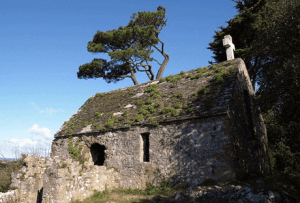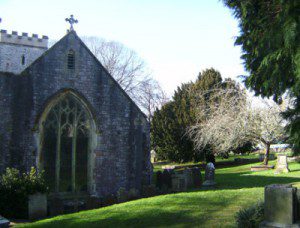It will soon be Halloween.
We’ve largely forgotten the meaning of the celebration but it was originally the Christian festival of All Hallows Day, the time of the year dedicated to remembrance of the dead. Halloween then evolved to use humour and ridicule to confront the power of death.

Here in Torquay we’ve not really bought into many of the modern Halloween activities such as trick-or-treating and carving pumpkins, practices so beloved by our American cousins. Yet, Halloween does give us an opportunity to explore the darker side of our town’s past. Though the coach parties remain, huddling around their budget Wetherspoon’s pints on the harbourside, most of the ‘grockles’ have departed. This gives us a few days to gaze into the lengthening shadow of the Torbay palm as our collective sun tan fades. Now is a time to abandon strict reality and indulge in a little fantasy and myth, Romanticism and the English Gothic.

We can remember the thousands who lost their lives at the end of a rope at Gallows Gate, and those left to rot on the gibbet placed there. We can also mourn the uncounted dead taken by storm or by Barbary Pirates in the Bay, and sympathise with the widows and orphans who lost loved ones to shipwreck. Those grieving families were fortunate if the bodies were rolled by the tides onto Abbey Sands or dashed in the sea caves of Corbyn Head – at least these were recovered while so many mouldered at the bottom of the sea.
Indeed, for centuries we feared what might be concealed beneath the waves. These were the nameless horrors recognised in HG Wells’ story ‘The Sea Raiders’ (1896) which featured a series of attacks on bathers and boats along South Devon’s coast. They were, “ghastly-looking creatures, in shape somewhat resembling an octopus, with huge and very long and flexible tentacles. The skin had a glistening texture, unpleasant to see, like shiny leather. The tentacle-surrounded mouth, and the large intelligent eyes, gave the creatures a grotesque suggestion of a face.” Maybe they’re still out there…

According to many scholars, Halloween has much older Pagan roots in Celtic harvest festivals, particularly the Gaelic Samhain. Accordingly, in Torbay this time of year would have been celebrated by the Dumnonii people. Two thousand years ago Julius Caesar described how the Celts, under the direction of the enigmatic Druids, filled great wicker men with animals and humans and burned them alive. Intriguingly, it’s been suggested that the word Daison (the part of Torquay by Lymington Road) derives from the Old English daegsan meaning ‘a sacrificial stone’. Though the stories of human sacrifice may just be an early form of Celtophobia on the part of the Romans, what better place for this ritual than Daddyhole Plain? We further know that the Vikings came to the Bay. Did they ever practice their ghastly Blood Eagle executions on our shore?

Some Christians also had their darker side. They spent a good deal of their energy suppressing other beliefs and other Christians. The recently renovated St Michaels Chapel (below) opposite Torre Station, for example, may have been imposed on an older place of Pagan significance to show the triumph of the militant new faith.

Despite the best efforts of the Church local people continued for centuries to believe in the power of witches. When a Watcome house was being renovated in the 1970s a mummified cat was found behind the fireplace – the animal placed there to protect the inhabitants from evil spirits. Even though fear of witches receded as medicine and education provided other explanations and cures, in 1875 Torquay’s magistrates still received an application by a poor old woman in Chelston, who believed that her husband had perished through witchcraft.
Furthermore Satan, the great enemy of humanity, continued to lurk in our imaginations. Legend had it that he lived in the caves beneath Daddyhole Plain – Daddy being the old English for Devil. In February 1855 panic ensued when the Devil’s supposed cloven footprints were found in overnight snow in Barton.

Indeed, there’s a great deal of opaque myth and legend in our town and over the years we may well have taken many of our ghost tales from other places: Torre Abbey’s Spanish Lady; the Shrieking Nun of Ilsham Grange; Daddyhole’s Matilda who sold her soul to the Devil; the hermit’s spectre of St Michael’s Chapel; and the White Ghost of Barton Hall are just a few. These stories, nevertheless, acted to warn the unwary away from dangerous places – Kent’s Cavern had its malicious pixies – and dangerous people such as the smugglers who worked at night. These spectres were entertaining and exciting, so we may have to look to our Victorian tourist guides who were known to invent or import exciting stories to enhance their income.
Perhaps home-grown horrors were never enough. It was the Torquay-born explorer Richard Francis Burton who translated the Kama Sutra and introduced the British to the mysteries and unfamiliar gods of the East. Now we had new things to fear, foreign demons that would still feature in Hammer horror movies a century later.
In time our educated elite exchanged ghostly infestations for the more ‘scientific’ explorations of the supernatural in the form of animal magnetism, telepathy and Spiritualism – the latter becoming a blend of parlour game, entertainment and new religion.
Yet, while most of our ghosts just faded away, others came back with a vengeance.

In 1917 the Spiritualist Violet Tweedale (pictured below) investigated the Warberries’ long-haunted ‘Castel-a-Mare’ (above). One of Violet’s investigators was quickly possessed and had to be exorcised. Yet the violent spirit once more went on the offensive.

A few years later, when the writer Beverley Nichols (pictured below) visited, something, “black, silent and man-shaped rushed from the room and knocked him to the floor.”

We’ve always been fascinated by the occult in Torquay. From our very beginnings as a town we set up secret societies to explore hidden knowledge. Though now primarily philanthropic organisations, Torquay’s Freemasons (founded in 1810), the Oddfellows (1856), and the Foresters (1858) all claimed to have their roots in antiquity – in ancient Egypt, Rome or Anglo-Saxon Britain. They also used rituals that so concerned the established Church.
In parallel with the triumph of the rational and scientific, however, came an alternative outpouring of literature exploring the uncanny, with many of the great writers on the macabre and mysterious having associations with our town. Mary Shelley (Frankenstein); Robert Louis Stevenson (Dr Jekyll and Mr Hyde); Edward Bulwer-Lytton (The Haunters and the Haunted); Charles Dickens (A Christmas Carol); Arthur Conan Doyle (Sherlock Holmes); TS Eliot (The Waste Land); Rudyard Kipling (Tales of Horror); Oscar Wilde (Dorian Gray); Wilkie Collins (The Woman in White); Henry James (The Figure in the Carpet); Trevor Ravenscroft (The Spear of Destiny); Brian Lumley (Necroscope): all lived in or visited Torquay .
While many just saw the occult as entertainment, others were very serious. Did that most notorious of warlocks Aleister Crowley (‘the wickedest man in the world’ and pictured left) ever succeed in raising demons in his house in Barton? We also wish we knew more about the end-of-the-world cult who operated in Chelston in the 1880s. All we know is that the Order of the Temple occupied ‘Cloudlands’ with their leader, the Countess Marie Borel, who believed that her adopted son Prince Baptiste St John Borel had special powers. The Countess further understood herself to be the “woman clothed with the sun” who was “to bear the child to rule the world with a rod of iron”. Yet, we hear nothing more of her or the Prince, so sadly the Messiah wasn’t to come from a Torquay suburb.
Though now we proudly profess rationality, we’re not done with ghosts. People still report things that they can’t understand. The Clipper Inn in Melville Hill, for instance, retains the manifestation of a deceased gentleman who is to be glimpsed smoking his pipe in the bar.
On the other hand, there was always enough real horror in Torquay without the need for invention or make believe: Charlotte Winsor’s serial murder of babies in her lonely cottage at Lawe’s Bridge in 1865; the starvation which triggered riots; the exploitation of thousands in domestic service; and the sending of the mentally ill and ‘idiots’ to be deliberately degraded in Newton Abbot’s workhouse.

It may be that we tend to use the supernatural to put uncomfortable realities out of mind. Regardless, given time, repressed memory has a habit of making itself known. After cholera came to Torquay in 1849 we buried the open sewer that was the River Fleet – but not before the disease claimed the lives of 66 people in six weeks. Many of the dead were buried in Cholera Corner in Torre’s St. Saviours churchyard (pictured right), the graves unmarked as the victim’s families lacked the funds for memorial stones. If you stand outside Primark you can still hear the hidden river beneath your feet as it makes its way to the harbour. There’s a hidden power there and occasionally the buried torrent breaks its bounds and reveals itself once more… but that’s enough of metaphors.

Perhaps we’re more sophisticated now. We’ve moved on from demons, witches and ghosts. Nevertheless, while we can explain away our irrational fears, we still do like to be scared – there’s even a TV channel dedicated solely to Horror. We remain unaccountably uneasy in some places. This may be a deep-rooted evolutionary response – whether it’s a deserted African waterhole a million years ago or an eerie Castle Circus at 3AM, we instinctively don’t like it.
Our Halloween will soon be gone – next is the faux-jollity of Christmas. Meanwhile, we can indulge ourselves a little, and spend a few days considering the skull beneath Torquay’s skin.





























